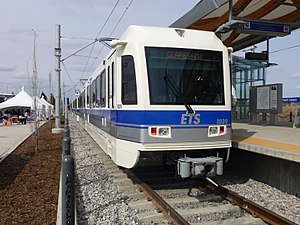Edmonton Light Rail Transit, commonly referred to as the LRT, is a light rail system in Edmonton, Alberta. Part of the Edmonton Transit Service (ETS), the system has 29 stations on three lines and 37.4 km (23.2 mi) of track. Much of the system has a dedicated right-of-way, while in the downtown area, vehicles run underground. This subway-surface alignment is known as semi-metro. As of 2018, it was number seven on a list of the busiest light rail transit systems in North America, with over 113,000 daily weekday riders.
The ETS started operation of the original LRT line in 1978, expanded by 2010 into the Capital Line, running between Clareview in Edmonton's northeast and Century Park in Edmonton's south end.[4] The first phase of the newer Metro Line started service between the University of Alberta campus and hospital in Edmonton's south-central and the Northern Alberta Institute of Technology northwest of downtown Edmonton in 2015, with further expansion to north Edmonton and neighbouring city of St. Albert planned into the future.[5] Construction of the first phase of the 27-kilometre (17 mi) Valley Line, from downtown Edmonton to Mill Woods in southeast Edmonton, began in spring 2016, and opened November 4, 2023. Construction on the second phase of the Valley Line, connecting downtown to west Edmonton, began in fall 2021 and is scheduled for completion by 2028.[7][8][9]
- ^ De Leuw, Cather & Company (1976). Light Rail Transit: A State of the Art Review. Retrieved September 9, 2024.
- ^ "Transit Ridership Report Second Quarter 2024" (PDF). American Public Transportation Association. September 3, 2024. Retrieved September 5, 2024.
- ^ "Transit Ridership Report Fourth Quarter 2023" (PDF). American Public Transportation Association. March 4, 2024. Retrieved September 5, 2024.
- ^ a b "The Way We Move LRT for Everyone" (PDF). Edmonton Transit Service and City of Edmonton. pp. 4–5. Archived from the original (PDF) on September 10, 2015. Retrieved September 8, 2015.
- ^ a b "Metro Line (North LRT to NAIT)". City of Edmonton. September 7, 2015. Archived from the original on September 7, 2015. Retrieved September 8, 2015.
- ^ "Edmonton Datasheet - SD160 Light Rail Vehicle" (PDF). Siemens. Archived from the original (PDF) on October 26, 2010. Retrieved March 9, 2011.
- ^ Kent, Gordon (February 11, 2016). "'There's no hidden surprises,' city says, as it signs contract for Edmonton Valley Line LRT". Edmonton Journal. Postmedia Network. Retrieved February 13, 2016.
- ^ "Bechtel Team Awarded Edmonton Valley Line Light Rail Project in Canada". Bechtel. February 11, 2016. Retrieved February 13, 2016.
- ^ "City of Edmonton selects Marigold Infrastructure Partners for Valley Line West LRT project".



